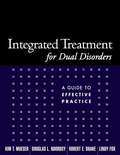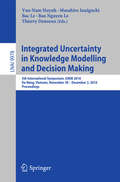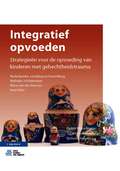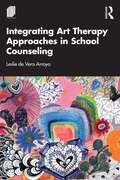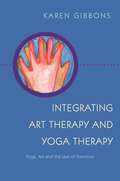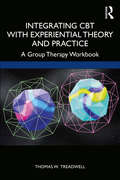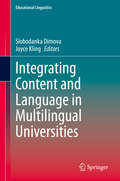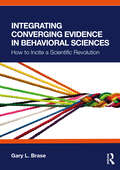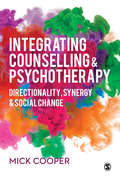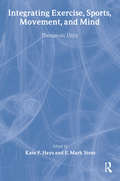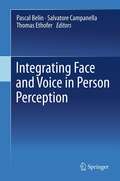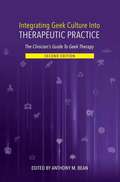- Table View
- List View
Integrated Treatment for Co-Occurring Disorders: Personality Disorders and Addiction
by Sharon C. EkleberryIntegrated Treatment for Co-Occurring Disorders addresses a complex client population, which presents service providers with significant professional challenges. Underlying personality disorders compromise treatment effectiveness for medical, other psychiatric, or trauma services, as well as the ability these individuals have in adhering to probation, parole, or court-ordered treatment requirements. A co-occuring substance use disorder amplifies the difficulties experienced by personality-disordered individuals, exacerbates the precarious nature of their relationships, and raises the skill level needed by service providers attempting to help them. There can be significant professional satisfaction in working effectively with the interplay of addiction and disorders of personality. The book brings focus to the specifics of assessment and treatment for this type of co-occurring disorder and suggests that greater adaptability, fewer self-sabotaging behaviors, and an abstinent lifestyle are all possible. Recovery from both disorders is the journey these individuals take toward greater maturation, reliable impulse control, and coping skills that are not dependent upon the evasion of the demands of living or use of substances to manage stress or uncomfortable affect. Recovery is possible, and service providers can assist these clients on their path to wellness.
Integrated Treatment for Dual Disorders: A Guide to Effective Practice
by Robert E. Drake Kim T. Mueser Kim Tornvall Mueser Lindy Fox Douglas L. NoordsyThis comprehensive clinical handbook provides virtually everything needed to plan, deliver and evaluate effective treatment for persons with substance abuse problems and persistent mental illness. From authors at the forefront of the dual disorders field, the book is grounded in decades of influential research. Presented are clear guidelines for developing integrated treatment programmes, performing state-of-the-art assessments, and implementing a wide range of individual, group and family interventions. Also addressed are residential and other housing services, involuntary interventions, vocational rehabilitation, and psychopharmacology for dual disorders. Throughout, the emphasis is on workable ways to combine psychiatric and substance abuse services into a cohesive, unitary system of care. The volume contains all needed assessment forms, treatment planning materials and client handouts, most of which include permission to photocopy.
Integrated Treatment for Personality Disorder
by W. John Livesley John F. Clarkin Giancarlo DimaggioRather than arguing for one best approach for treating personality disorder, this pragmatic book emphasizes the benefits of weaving together multiple well-established intervention strategies to meet each patient's needs. A framework is provided for constructing a comprehensive case formulation, planning treatment, and developing a strong therapeutic alliance. The clinician is guided to utilize techniques from all major therapeutic orientations to address transdiagnostic personality symptoms and problems involving emotion regulation, interpersonal functioning, and self and identity. Showing how to pick and choose from "what works" in a thoughtful, coordinated fashion, the book features rich clinical illustrations, including a chapter-length case example.
Integrated Uncertainty in Knowledge Modelling and Decision Making
by Van-Nam Huynh Thierry Denoeux Masahiro Inuiguchi Bac Le Bao Nguyen LeThis book constitutes the refereed proceedings of the International Symposium on Integrated Uncertainty in Knowledge Modeling and Decision Making, IUKM 2013, held in Beijing China, in July 2013. The 19 revised full papers were carefully reviewed and selected from 49 submissions and are presented together with keynote and invited talks. The papers provide a wealth of new ideas and report both theoretical and applied research on integrated uncertainty modeling and management.
Integratief opvoeden: Strategieën voor de opvoeding van kinderen met gehechtheidstrauma
by Cathy Schweitzer Debra Wesselmann Stefanie ArmstrongDit boek biedt specifieke opvoedstrategieën voor opvoeders van chronisch getraumatiseerde kinderen. Deze opvoedstrategieën zijn te gebruiken door ouders/pleegouders, familieleden en anderen die een kind verzorgen dat gehechtheidstrauma heeft meegemaakt. Ook kan het boek gebruikt worden door therapeuten om een behandeling te ondersteunen, waarbij EMDR en gezinstherapie wordt geïntegreerd (zoals IGT-K). Kinderen die nare gebeurtenissen hebben meegemaakt binnen hun gehechtheidsrelaties door mishandeling, verwaarlozing, medische ingrepen of uithuisplaatsingen ervaren intense pijn, angst en wantrouwen. Deze diepe gevoelens uiten zich vaak in ‘lastig’ gedrag, agressie en/of extreme geslotenheid, zelfs nadat de thuisomgeving is veranderd door adoptie, pleeggezinplaatsing, een voogdijmaatregel of het oplossen van problemen thuis. Integratief opvoeden geeft informatie over de invloed van gehechtheidstrauma op de hersenontwikkeling. Je krijgt vaardigheden en strategieën aangereikt die het functioneren van je kind kunnen verbeteren. Je zal leren hoe je benodigdheden om de gehechtheid te bevorderen (zoals affectie, emotionele afstemming en spel) kunt inzetten om de kloof tussen jou en je kind te overbruggen. Mindfulness en strategieën om de hersenen van je kind te kalmeren zullen je kind ondersteunen om te reflecteren op zijn eigen gedachten, gevoelens en keuzes. Hierdoor leert hij om op een effectievere manier beslissingen te gaan maken. Het oorspronkelijke boek Integrative Parenting werd geschreven door ervaren therapeuten uit de Verenigde Staten: Debra Wesselmann, Cathy Schweitzer en Stefanie Armstrong. Integratief opvoeden is de Nederlandse editie. De vertaling en bewerking is verzorgd door Nathalie Schlattmann, klinisch psycholoog, EMDR- en TF-CBT supervisor, Mara van der Hoeven, orthopedagoog en onderzoeker, en Irma Hein, kinderpsychiater en onderzoeker. Alle drie zijn zij verbonden aan Levvel, specialisten voor jeugd en gezin, te Amsterdam.
Integrating Acceptance and Commitment Therapy with Islamic Psychotherapy for Managing Chronic Pain (Islamic Psychology and Psychotherapy)
by Razia Bhatti-AliThis book proposes a psychotherapeutic intervention integrating Islāmic Psychology with Acceptance Commitment Therapy (ACT) for Muslims with chronic pain conditions. The first part of the book provides an overview of the challenges of living with chronic pain and illness and explores the cultural expressions of pain and disease and a literature review on culturally adapted psychotherapies. An overview of the main components of ACT and their congruence with Islāmic tenets, including spirituality and contemplation, is provided to propose an Islāmic based ACT approach that aims not to reduce or eliminate pain but rather to help the client build a repertoire of behaviours that lead them towards value-based directions. The second part of the book outlines a session-by-session cultural adaptation of the six core processes of ACT interwoven with Islāmic teachings from the Quran and Sunnah. The book is supplemented with downloadable resources such as worksheets and handouts that professionals can use in practice. This book is intended as a pain management guide for therapists familiar with ACT and Islām. It will provide therapists with the tools to deliver a faith-adapted, evidence-based treatment for clients who follow the Islāmic faith.
Integrating Art Therapy Approaches in School Counseling
by Leslie de Vera ArroyoUsing this book, school counselors can increase their knowledge on the benefits of art therapy approaches in school counseling. This book serves as a frame of reference for school counselors to use throughout their careers, as it includes examples of integrating art into direct school counseling services, art directives and prompts, case studies, and how to process art in a safe and inclusive way within the school counselor role. While gaining an understanding of the history of art therapy, readers will learn how the use of art in school counseling practice aligns with the American School Counselor Association (ASCA) National Model to support student achievement and overall well-being. The author holds a master’s degree in art therapy and licensure in school counseling and speaks on behalf of both fields and their benefits, allowing for school counselors to incorporate art therapy-informed practices into their program.Readers will recognize that art is a valuable resource to obtain the information they need from students in a creative way, and as an alternative and/or supplement to the traditional talk therapy counseling session.
Integrating Art Therapy and Yoga Therapy: Yoga, Art, and the Use of Intention
by Karen GibbonsThis dynamic approach to therapy combines yoga and art to heal the whole person - body, mind and spirit - through the use of intention. In this practical guide art therapists will learn how to incorporate yoga poses, mudras and meditation, and yoga therapists to introduce art directives, into individual and group clinical work for a more holistic healing process. Readers will discover the parallels that exist between the two modalities, and how to use a specific intention as a framework for structuring sessions, with the aim of reaching a deeper level of healing in their clinical work. Guidelines for staying within each modality's scope of practice and working ethically are included, as well as an extensive Practice Chart, which shows how to match treatment concerns with an intention, mudra meditation, yoga poses and art activity. Ideal for art therapists looking to expand and enhance their practice, this book will also appeal to yoga therapists and teachers with an interest in art-based techniques. Although primarily meant for therapists, it is also accessible for individuals looking for self-improvement.
Integrating Art Therapy and Yoga Therapy: Yoga, Art, and the Use of Intention
by Karen GibbonsThis dynamic approach to therapy combines yoga and art to heal the whole person - body, mind and spirit - through the use of intention. In this practical guide art therapists will learn how to incorporate yoga poses, mudras and meditation, and yoga therapists to introduce art directives, into individual and group clinical work for a more holistic healing process. Readers will discover the parallels that exist between the two modalities, and how to use a specific intention as a framework for structuring sessions, with the aim of reaching a deeper level of healing in their clinical work. Guidelines for staying within each modality's scope of practice and working ethically are included, as well as an extensive Practice Chart, which shows how to match treatment concerns with an intention, mudra meditation, yoga poses and art activity. Ideal for art therapists looking to expand and enhance their practice, this book will also appeal to yoga therapists and teachers with an interest in art-based techniques. Although primarily meant for therapists, it is also accessible for individuals looking for self-improvement.
Integrating Behaviorism and Attachment Theory in Parent Coaching
by Beth TroutmanThis practical guide provides a robust positive-parenting framework for professionals coaching parents of infants, toddlers, and primary school children. The first half of the book explains behaviorist and attachment theories of parenting, comparing, contrasting, and synthesizing them into an effective, research-informed approach to practice. The second half shows these guidelines in action, using play therapy as a means to improve disruptive child behaviors, correct harsh parenting practices, and address root causes of adversarial parent-child relationships. Throughout these chapters, vivid composite cases demonstrate not only common parent-child impasses but also therapist empathy, flexibility, and self-awareness. This innovative text: Makes a rigorous case for a combined behavioral/attachment approach to parent coaching. Reviews current data on behavioral and attachment-based parenting interventions. Details the use of an attachment-informed approach to providing behavioral interventions such as Parent-Child Interaction Therapy and Helping the Noncompliant Child. Illustrates how parent coaching can be tailored to match different patterns of attachment. Includes tools for evaluating coaching sessions. Integrating Behaviorism and Attachment Theory in Parent Coaching is an essential guide for professionals, graduate students, and researchers in clinical, child and school psychology, social work, pediatrics, mental health counseling, and nursing.
Integrating Body Self & Psychological Self
by David W. KruegerFirst published in 2002. Routledge is an imprint of Taylor & Francis, an informa company.
Integrating Brain, Mind, Soul, and Spirit: Exploring Transpersonal Psychology, Psychedelics, and Altered States of Consciousness
by Eric John ParkinsReferring to major spiritual traditions, transpersonal psychology, neuropsychology, neuroscience, and modern physics, this book identifies and systematically integrates core ideas concerning psychospiritual development.Integrating Brain, Mind, Soul, and Spirit presents neuropsychological research on psychedelics, with reference to mystical experience, and Psi/extrasensory perception as an extension of cognitively controlled brain-based homeostasis. The book equates concepts from modern physics with perennial metaphysics concerning intelligent consciousness, evolution, and the transfer of energy and information. It also compares spiritual literature regarding consciousness, spirit-soul, and brain-mind personality, to neuropsychological and psychological literature concerning emotion, cognition, and altered states of consciousness. Finally, a nested neuro-psycho-spiritual control hierarchy is presented as an architecture for systematically integrating; describing; and understanding brain, mind, soul, and spirit, and neuro-psycho-spiritual development.Providing a modern multidisciplinary perspective, and highlighting implications for psychiatry, psychotherapy, and education, this book is a must-read for students and researchers of transpersonal psychology, psychospiritual matters, and altered states of consciousness.
Integrating CBT and Third Wave Therapies: Distinctive Features (CBT Distinctive Features)
by David Pearson Fiona KennedyIntegrating CBT and Third Wave Therapies offers a thought-through approach to integrating evidence-based therapies. It provides help for all of us who are developing or have expertise in a variety of evidence-based approaches. The theoretical part of the book briefly reviews four therapies, namely: CBT, DBT, ACT and CFT. The authors identify core processes of change and examine how each therapy contributes to each core process, helping in the integration of all four. The text considers the influence of early adversity on later mental wellbeing, the theoretical underpinnings of mindfulness, behaviour analysis, reliving and re-scripting and dissociation. Theory and practice chapters are illustrated using case vignettes. The book will be useful for therapists to structure sessions with clients. It demonstrates how to follow a theoretical approach and offers a therapeutic structure for integrated clinical work. It will be useful in reflective practice and supervision, and for students learning about a variety of therapeutic approaches.
Integrating CBT with Experiential Theory and Practice: A Group Therapy Workbook
by Thomas W. TreadwellThis workbook elucidates the techniques clinicians will encounter using the cognitive experiential (psychodrama) group therapy (CEGT) model. This model incorporates cognitive behavioral and psychodramatic interventions to help identify and modify negative thinking, behavior, and interpersonal patterns. Beginning with a brief overview of cognitive behavioral therapy (CBT) and psychodrama, the book highlights concepts and techniques that are most relevant to CEGT session content. The second half of the workbook provides a description of CEGT and what group members should expect through their engagement in this therapy. Featured throughout are tables and exercises that create pathways to challenge dysfunctional thinking along with blank worksheets to be used by group members located in the appendices. Readers will learn techniques to challenge negative thought patterns and increase engagement in positive and success-based experiences through clear guidelines for behavioral interventions to help move individuals from negativity to a more positive life space.
Integrating Career Development and Mental Health in Counseling
by Seth C. HaydenThe connection between career development and mental health has long been established within research as mutually impactful. Given this reality, there are significant implications for counselors working in various settings. Important societal movements focused on increasing access and equity for those with intersectional identities of ethnicity, race, gender, sexual identity, and ableism are rooted in the transformational power of career and work. This speaks to the centrality of career development in the human experience. The recent events of the pandemic have magnified awareness of the impact of struggles with career and work on overall well-being. Given these considerations, counselors are tasked with providing comprehensive and holistic support that addresses co-occurring career and mental health concerns. Integrating Career Development and Mental Health Counseling focuses on counseling-centered approaches that integrate dimensions of career and mental health. Whether providing counseling in a community agency, K-12 school, private practice, college/university, or other institution, having the capability to address career concerns is essential to comprehensive counseling support. Relevant dimensions of career theory, research, and practice are included. Theoretically and empirically supported interventions that address co-occurring career and mental health concerns are also provided. Additional Information To purchase print copies, please visit the ACA Store. Reproduction requests for material from books published by ACA or any other questions about ACA Publications should be directed to publications@counseling.org. ACA will provide one complimentary Desk Copy to faculty and other instructors who have adopted an ACA text for their course. To request a Desk Copy, please go to: https://www.counseling.org/publications/overview/product-ordering-information Digital evaluation copies may be requested from Wiley by clicking the link above and completing the details about your institution and course.
Integrating Content and Language in Multilingual Universities (Educational Linguistics #44)
by Joyce Kling Slobodanka DimovaThis volume provides conceptual syntheses of diverging multilingual contexts, research findings, and practical applications of integrating content and language (ICL) in higher education in order to generate a new understanding of the cross-contextual variation. With contributions from leading authors based in Asia, the Middle East, and Europe, the volume offers comparison of contextualized overviews of the status of ICL across the geographic areas and allows us to identify patterns and advance the scholarship in the field. ICL in teaching and learning has become an important consideration in the endeavors to address linguistic diversity at universities, which has resulted from the growing teacher and student mobility around the world.
Integrating Converging Evidence in Behavioral Sciences: How to Incite a Scientific Revolution
by Gary L. BraseIntegrating Converging Evidence in Behavioral Sciences presents a fresh approach to understanding the landscape of scientific research, particularly within the behavioral sciences.By examining the needs for consistency and coherence across different scientific disciplines, this book offers readers a practical framework for evaluating and advancing their research topics. Through a comprehensive overview of established frameworks such as Marr’s computational framework and Tinbergen’s four questions, the book introduces a novel convergence framework specifically tailored to the behavioral sciences. This approach enables a more integrated view of scientific theories and knowledge, empowers researchers to pinpoint areas of high impact, and helps them to recognize potential revolutions in the field. The book serves a dual purpose: As a rubric for students and early-career researchers to grasp and navigate their research topics, and also as a resource for more advanced researchers seeking to delve into deeper issues and apply the framework across different contexts.This book is an essential guide for anyone interested in harmonizing scientific perspectives, developing more robust and interconnected fields of research, and potentially paving the way for groundbreaking discoveries.
Integrating Counselling & Psychotherapy: Directionality, Synergy and Social Change
by Professor Mick CooperHow can therapists integrate theories and practices from across the psychological therapies? This book presents a framework for understanding distress and change that can unite different orientations, along with sociopolitical perspectives. Its starting point is that therapy aims to help clients move towards the things they most deeply want. It shows how the actualisation of these ‘directions’ leads to greater well-being, and how this can be brought about through the development of internal and external synergies. Using in-depth cases, the book provides detailed guidance on how this framework can be applied. After reading this book, you’ll feel better equipped to understand, and work with, your clients’ directions—tailoring the therapy to their unique wants.
Integrating Counselling & Psychotherapy: Directionality, Synergy and Social Change
by Professor Mick CooperHow can therapists integrate theories and practices from across the psychological therapies? This book presents a framework for understanding distress and change that can unite different orientations, along with sociopolitical perspectives. Its starting point is that therapy aims to help clients move towards the things they most deeply want. It shows how the actualisation of these ‘directions’ leads to greater well-being, and how this can be brought about through the development of internal and external synergies. Using in-depth cases, the book provides detailed guidance on how this framework can be applied. After reading this book, you’ll feel better equipped to understand, and work with, your clients’ directions—tailoring the therapy to their unique wants.
Integrating Emotions and Cognition Throughout the Lifespan
by Gisela Labouvie-ViefThis book synthesizes the literature on emotional development and cognition across the lifespan. The book proposes a core language by which to describe positive and problematic developmental changes by recourse to a parsimonious set of core principles, such as elevations or declines in tension thresholds and their relation to the waxing and waning of the cognitive system over the life course. It integrates, similarly, the lifelong consequences of the positive or damaging aspects of the social milieu in fostering increases in tension thresholds with their advanced capacity for maintaining equilibrium and warding off stress versus a lowering of tension thresholds with disturbances of equilibrium maintenance and heightened susceptibility to stress and deregulation.
Integrating Exercise, Sports, Movement, and Mind: Therapeutic Unity
by Kate F HaysRead Integrating Exercise, Sports, Movement, and Mind: Therapeutic Unity, and you’ll see how exercise and movement are actually the keys to achieving a harmonious equilibrium between thoughts and physical health. This unique collection of writing, a healthy and diverse montage in its own right, mirrors its topic, helping you see how a variegated array of body movements can lead to a healthier, happier mind.A kaleidoscope of theory and application, case study and abstraction, Integrating Exercise, Sports, Movement, and Mind spans the spectrum of relevant issues, including those revolving around gender, class, ethnicity, and family systems, and accomplishes its task through the medium of a wide assortment of activities, including gymnastics, soccer, horseback riding, archery, running, walking, and cycling. Your perspective on body movement and body-mind unity will be deepened as you read about these topics: family system perspectives and youth sports rehabilitation--“patient as athlete” contact Improvisation the concept of “flow” from within a gendered consciousness sport psychology and the coach/athlete/consultant triad clinical sport psychology sport trauma recoveryIt’s a unique but universal relationship--this prism of thoughts and physical locomotion. So open up Integrating Exercise, Sports, Movement, and Mind and let some of the top experts in the field of sport psychology open your mind and show you how to unlock the body’s potential on the athletic field.
Integrating Expressive Arts and Play Therapy with Children and Adolescents
by Athena A. Drewes Eric J. GreenPraise for Integrating Expressive Arts and Play Therapy With Children and Adolescents"With this book, Drs. Green and Drewes have filled an important void in the play therapy literature, namely the integration of the expressive arts in play therapy with children and adolescents. They have assembled the best theorists and practitioners of the expressive arts and given them an appropriate structure to write their chapters. The book is outstanding and provides readers with in-depth case studies, detailed methodologies, research findings and is a useful resource for further training options. I recommend this book most highly for trainers, practitioners, and graduate students."-John Allan, PhD, Professor Emeritus of Counseling Psychology, University of British Columbia, author, Inscapes of the Child's World"Brimming with chapters by 'oracles' from various disciplines, Green and Drewes' guidebook articulates essential competencies for the cross-disciplinary practice of play therapy and expressive arts therapies. Practical and timely, responsible and readable, it is an important resource for the mental health community and students who seek to work creatively with children. A significant contribution toward bringing professionals and professions together to learn from one another."-Barry M. Cohen, MA, ATR-BC, founder, Expressive Therapies Summit, cofounder, Mid-Atlantic Play Therapy Training InstituteInterventions and approaches from the expressive arts and play therapy disciplinesIntegrating Expressive Arts and Play Therapy With Children and Adolescents presents techniques and approaches from the expressive and play therapy disciplines that enable child and adolescent clinicians to augment their therapeutic toolkit within a competent, research-based practice.With contributions representing a "who's who" in the play therapy and expressive arts therapy worlds, Integrating Expressive Arts and Play Therapy With Children and Adolescents is the definitive bridge between expressive arts and play therapy complementarily utilized with children and adolescents in their healing and creative capacities.
Integrating Face and Voice in Person Perception
by Pascal Belin Thomas Ethofer Salvatore CampanellaThis book follows a successful symposium organized in June 2009 at the Human Brain Mapping conference. The topic is at the crossroads of two domains of increasing importance and appeal in the neuroimaging/neuroscience community: multi-modal integration, and social neuroscience. Most of our social interactions involve combining information from both the face and voice of other persons: speech information, but also crucial nonverbal information on the person's identity and affective state. The cerebral bases of the multimodal integration of speech have been intensively investigated; by contrast only few studies have focused on nonverbal aspects of face-voice integration. This work highlights recent advances in investigations of the behavioral and cerebral bases of face-voice multimodal integration in the context of person perception, focusing on the integration of affective and identity information. Several research domains are brought together. Behavioral and neuroimaging work in normal adult humans included are presented alongside evidence from other domains to provide complementary perspectives: studies in human children for a developmental perspective, studies in non-human primates for an evolutionary perspective, and studies in human clinical populations for a clinical perspective. Several research domains are brought together. Behavioral and neuroimaging work in normal adult humans included are presented alongside evidence from other domains to provide complementary perspectives: studies in human children for a developmental perspective, studies in non-human primates for an evolutionary perspective, and studies in human clinical populations for a clinical perspective. Several research domains are brought together. Behavioral and neuroimaging work in normal adult humans included are presented alongside evidence from other domains to provide complementary perspectives: studies in human children for a developmental perspective, studies in non-human primates for an evolutionary perspective, and studies in human clinical populations for a clinical perspective. Several research domains are brought together. Behavioral and neuroimaging work in normal adult humans included are presented alongside evidence from other domains to provide complementary perspectives: studies in human children for a developmental perspective, studies in non-human primates for an evolutionary perspective, and studies in human clinical populations for a clinical perspective.
Integrating Geek Culture Into Therapeutic Practice: The Clinician's Guide to Geek Therapy
by Anthony M. BeanHave you ever had a client who talks about Video Games, Dungeons and Dragons, Anime, or Comic Books? Likely they identify as a Geek. Being a geek can be seen as difficult for many; the social awkwardness, ineptitude, and judgment from others leads individuals to feel isolated in a world of their own. Geeks, by traditional definition, are passionate about anthologies and characters from a variety of fictional, fantasy, and virtual formats that are sometimes niche or unpopular, creating feelings of relatedness towards avatar experiences in an often otherwise lonely life. Integrating Geek Culture into Therapeutic Practice: The Clinician's Guide to Geek Therapy is a comprehensive compendium of how Geek Therapy clinicians and scholars currently use a variety of games, media artifacts, and other geek culture items in therapeutic context and intervention. Even more important, the authors within this book are currently at the forefront of their research fields and are accordingly considered experts within the growing field of Geek Therapy clinical practice. Throughout the book, leading researchers within the field of Psychology, Communication Studies, and more have been able to provide clinical examples, research-based approaches, and specifics about how to utilize these items therapeutically - further enhancing the material and providing solid supportive guidance for clinicians. Clinicians reading this can develop further competence and understanding of the concepts found within their practices which will be helpful for their personal success and cultural competence to best serve their clientele. These modalities have resulted in clients experiencing: Reduced anxiety and depressive symptoms Improved self-esteem Richer interpersonal interactions Greater social and school engagement and Superior development of social skills and problem solving These techniques are being used to improve overall psychological well-being across all ages, as well as focusing on the specific needs of targeted populations, such as those with ADHD, ASD, PTSD, and mood and anxiety disorders.
Integrating Human and Artificial Intelligence: Software in the Age of AI
by Stephen K. ReedThis timely book captures recent developments in artificial intelligence (AI) and their far-reaching implications across education, cognition, business, healthcare, and environmental sectors.Drawing from current academic research, government reports, and industry insights, Integrating Human and Artificial Intelligence provides a comprehensive yet accessible overview of the rapid evolution of AI. It helps readers understand in non-technical terms what AI is, what it is capable of achieving, and how to combine the best skills of artificial and human intelligence to develop a human-centered AI. This will be vital to overcome challenges to protect data privacy, promote fairness, minimize bias, and be culturally responsive. The book's broad scope and contemporary focus make it a welcome addition to the field, especially as an educational resource introducing students and practitioners to the practical applications and societal impact of AI.Well-grounded in recent scholarship, this book will be particularly valuable for students and researchers of cognitive psychology, AI, and technology.

